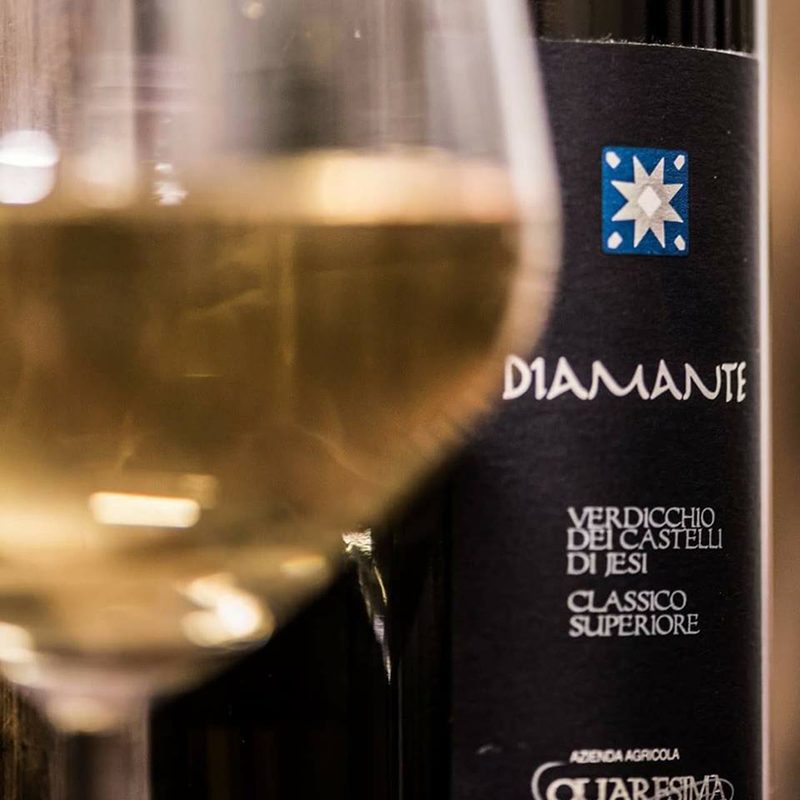{: it}Diamante – Verdicchio DOC Classico Superiore (Az Agricola Quaresima)
by Massimiliano Giorgi
Even the most parochial Vallesina winemaker is forced to recognize that Cupramontana is the heart of the land of Verdicchio. Verdicchio means Marche, it is its ambassador on tables in the world, it was the first DOC of this region.
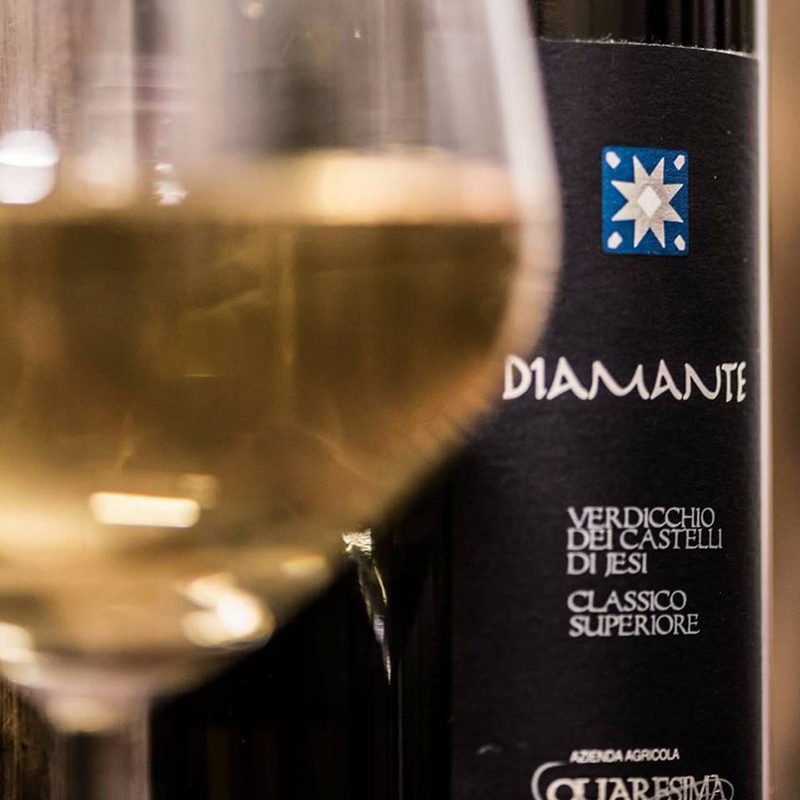 Vines have been cultivated here for more than 1200 years. Perhaps in the 800th century (yes, without the thousand in front) they still didn't call it Verdicchio, but it was in those years that the first "cuprensi" settled down to grow grapes in what is now the Morella district, in the S. Michele area, and in make those grapes the grandfather of Verdicchio.
Vines have been cultivated here for more than 1200 years. Perhaps in the 800th century (yes, without the thousand in front) they still didn't call it Verdicchio, but it was in those years that the first "cuprensi" settled down to grow grapes in what is now the Morella district, in the S. Michele area, and in make those grapes the grandfather of Verdicchio.
It is in Morella that today the Quaresima family creates the Diamante.
They call it Diamante, the Quaresima, because it is the excellence of their production: this year 2016 produced just 2661 bottles of Diamante (however double that of last year, all the bottles numbered and signed one by one.
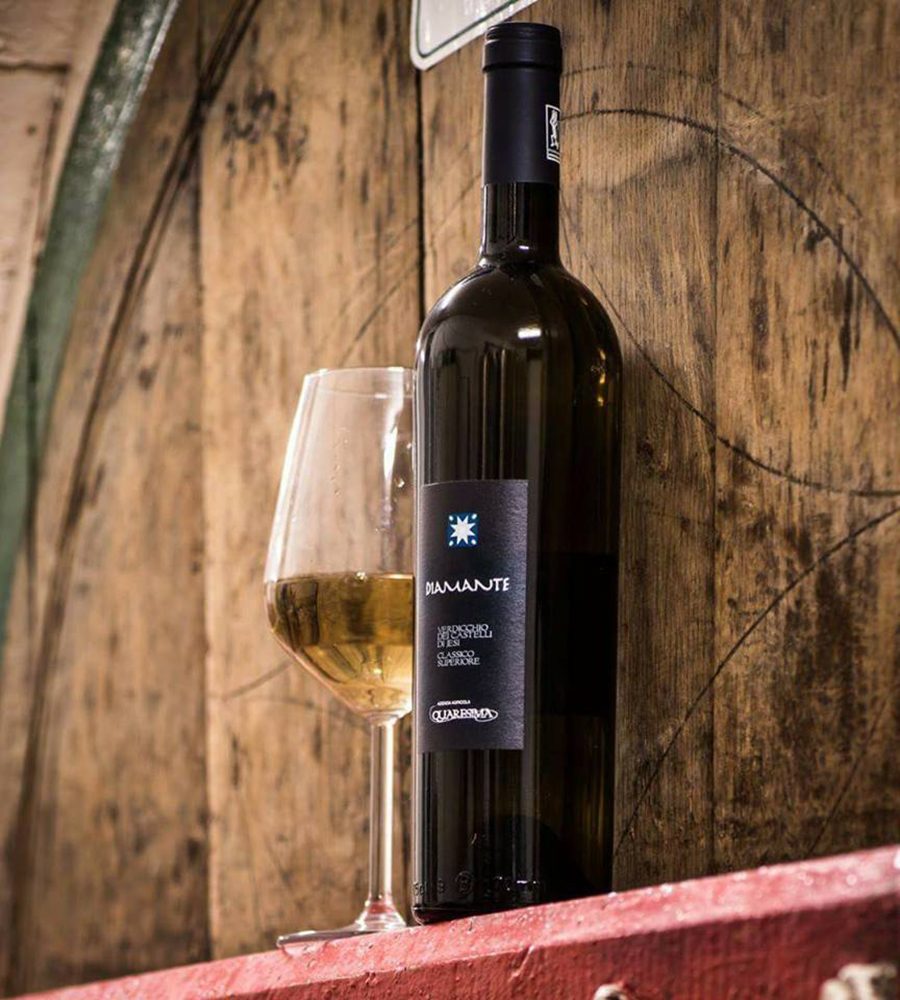 Selected grapes and not just so to speak: S. Michele is identified as the first and most important "terroir" in Cupramontana; for the Diamante, the northernmost vineyard of the Contrada Morella is cultivated, a calcareous and clayey soil at 450 meters above sea level, facing South-East. Only the 2 best bunches of the mother stock are chosen and the wine is made using only the free-run must and passed through membrane presses. The Diamante ferments for 20-30 days at 18°C and matures for another six months: from the barrels comes a Verdicchio with a typical straw color with green reflections, at over 14° alcohol.
Selected grapes and not just so to speak: S. Michele is identified as the first and most important "terroir" in Cupramontana; for the Diamante, the northernmost vineyard of the Contrada Morella is cultivated, a calcareous and clayey soil at 450 meters above sea level, facing South-East. Only the 2 best bunches of the mother stock are chosen and the wine is made using only the free-run must and passed through membrane presses. The Diamante ferments for 20-30 days at 18°C and matures for another six months: from the barrels comes a Verdicchio with a typical straw color with green reflections, at over 14° alcohol.
The characteristics of classic Verdicchio are all there so far. But when we open the bottle the particularity comes out, as befits every cru.
For me - a lover of the hardest Verdicchio possible, with clear and strong aromas and flavors - the Diamante is a pleasant surprise: it is that perfect balance for those who don't like the Classic (because the Diamante seems to only have the label of the Superior Classic), but it is not yet the demanding Riserva, which pushes you into “corksniffer” meditations.
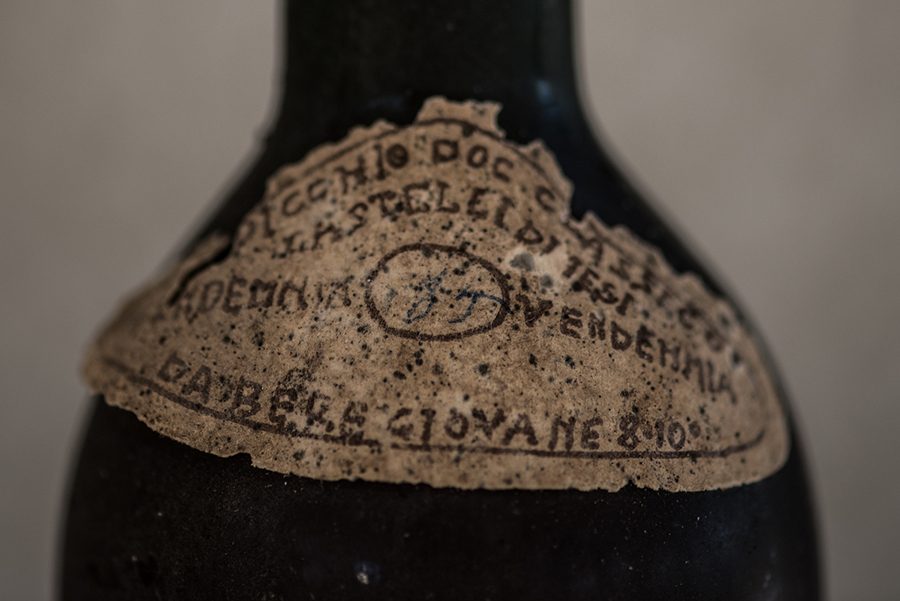 It is the fruit of a family history and this is demonstrated by the Diamante and the looks and words of the Quaresima family: Fabrizio Quaresima's eyes shine when he takes us into his grandmother's kitchen.
It is the fruit of a family history and this is demonstrated by the Diamante and the looks and words of the Quaresima family: Fabrizio Quaresima's eyes shine when he takes us into his grandmother's kitchen.
Literally: it was left intact and functioning on the farm, just as it was decades ago. Here it can happen, on one of those days where they organize a table or a tasting, or one of the many guided events that are held for our cellars, to smell the aromas of that home cooking that we Marche people - all of us! – we have imprinted in our memory.
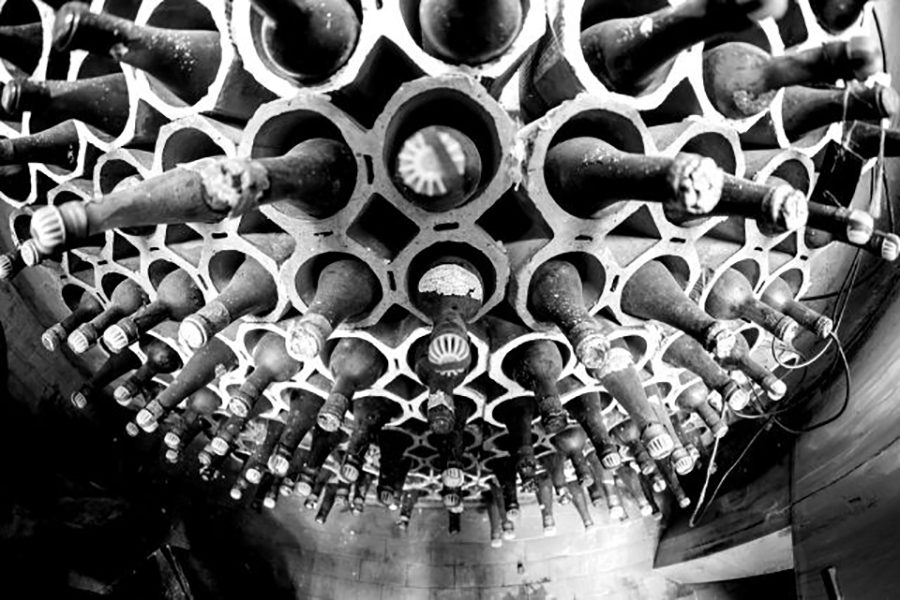 Fabrizio's eyes shine when he tells us about the Sunday lunches cooked by his grandmother, in that same place, while he opens the bottles one by one and lets us taste them (the Filello verdicchio, then the Zuave, made with apricots, and then Could the Visciola wine have been missing?), describing the flavours, one by one, where the vineyard from which it is made is located, the name of the person who takes care of the plants: "Grandpa doesn't even let me go near where the grapes for Diamante grow and I think he'll hit me up if he finds me!". A few more decades, it seems, before we can pass on all the family secrets, the "recipes". Yes, because it is not enough to write "Verdicchio" or "Visciola" to have a good product, much less something superior to the many already tasted.
Fabrizio's eyes shine when he tells us about the Sunday lunches cooked by his grandmother, in that same place, while he opens the bottles one by one and lets us taste them (the Filello verdicchio, then the Zuave, made with apricots, and then Could the Visciola wine have been missing?), describing the flavours, one by one, where the vineyard from which it is made is located, the name of the person who takes care of the plants: "Grandpa doesn't even let me go near where the grapes for Diamante grow and I think he'll hit me up if he finds me!". A few more decades, it seems, before we can pass on all the family secrets, the "recipes". Yes, because it is not enough to write "Verdicchio" or "Visciola" to have a good product, much less something superior to the many already tasted.
And can't you let me feel the Diamond? I ask Fabrizio petulantly. “No, you take it home and then tell me” is the answer.
I waited a few days, preparing my taste buds (read: stopped the Tuscan, returned to the sweeter Habanos) and then, taking a risk, instead of being on the safe side with a fish fry ("with Verdicchio it's the death of him" they say, they agree even the historical adversaries from Ancona!); I risked some banal macaroni, drowned in a ragù. The "sugo del batte", the most Marche sauce there is, the one that was prepared in the countryside during the threshing of the wheat. Oh yes, because a great Verdicchio goes with everything
Vines: 100% Verdicchio.
- Area of origin:Cupramontana (AN).
- Plant density:1000 vines/ha.
- Training Sistem:
- Average age of the vines:25 years.
- Yield per hectare:33 quintals of grapes.
- Bottles produced:700
- Alcohol content:14,
- Vinification and ageing:blank.
- Fermentation:30 days.
- Aging: 6 months.
- Color:Pale straw yellow with strong green reflections.
{:} {: en}Diamante – Verdicchio DOC Classico Superiore (Farm Quaresima)
Even the most parochial among wine producers of the Vallesina has to acknowledge that Cupramontana is the heart of the territory of wine grape variety Verdicchio. Verdicchio means Marche, it is actually an ambassador on the tables all around the world, and was the first DOC (Denomination of Controlled Origin) to be certified in this region.
Vineyards have been cultivated there for more than 1200 years. Maybe in the Ninth century it was not called Verdicchio, but it was in that century that the first inhabitants in Cupramontana settled down and farmed vine in Contrada Morella, in the S. Michele area, and those grapes became the grandfather of Verdicchio.
Nowadays it is in fact in Contrada Morella that family Quaresima produces Diamante.
The farmers Quaresima named the wine Diamante, since this is an excellence among their products: in 2016 only 2661 bottles of Diamante were produced (production was doubled compared to the previous year), each bottle is numbered and signed one by one.

Selected grapes actually: S. Michele is registered as the first and most important "terroir" in Cupramontana; Diamante is produced on the vineyard on the north side of Contrada Morella, its soil is chalky and clayish, 450 meters above sea level, South-East facing.
Only the best 2 bunches of the main vine log are chosen and wine is made out of the first must and see into membrane wine press. Diamante ferments for 20-30 days at a temperature of 18°C and then rests for six months: Verdicchio with its typical straw yellow and green shades comes out of the barrel, 14° of alcohol.
It includes all the main features of typical Verdicchio, but it is not enough. When you open the bottle, its peculiarity comes to life, as it happens for every Cru.
For me – a strong Verdicchio enthusiast, particularly of wine with strong and defined aroma and taste – Diamante is a pleasant surprise: it represents a perfect balance for those who do not appreciate Classico (Diamante seems to have only a label of Classico Superiore), but it is not yet too demanding as Riserva that would request “corksniffer” meditation.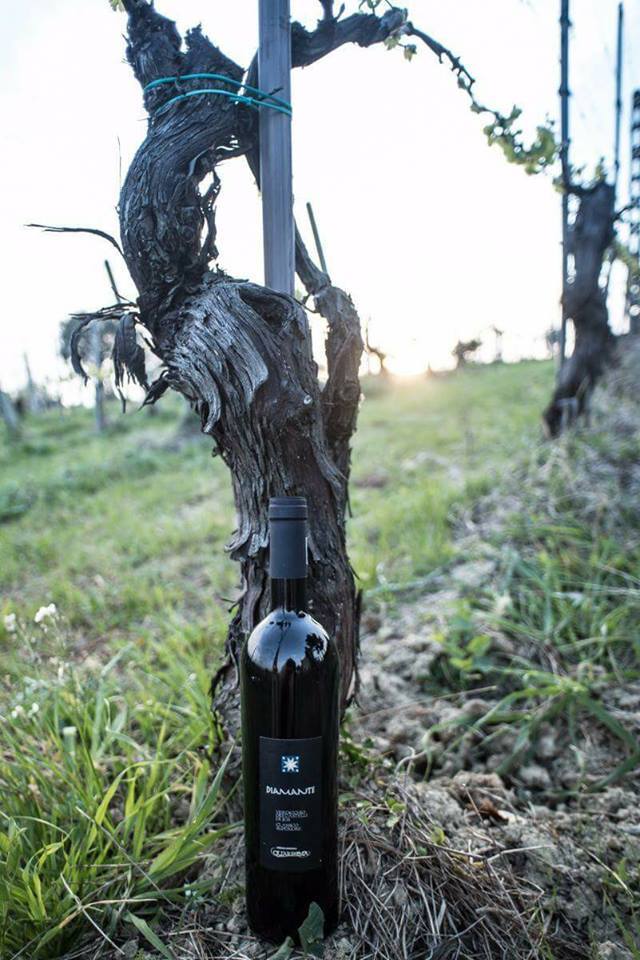
It is the result of the history of a family, and Diamante demonstrates that, and also the gaze and the words of Quaresima: Fabrizio Quaresima's eyes twinkle when he shows his grandma's kitchen to us.
Literally: it was kept untouched and useable inside the farm, as it used to be in the past decades. There you could smell the real taste of the kitchen of the homes of the Marche, that everyone there knows well, maybe during the tasting events or the tours in the wine cellar.
Fabrizio's eyes twinkle when he tells about the Sunday lunch prepared with love by his grandma, in that same place, while he opens a bottle and lets us taste some good wine (Verdicchio Filello, then Zuave made with apricots, and then the special sour cherry wine), telling one by one the taste of the place where the vineyard is located, the name of the one who takes care of the plants: “Grandpa does not even allow me to go near to the grapes used to produce the Diamante, he would certainly beat me up, if he finds me nearby!”. Still few decades before he would transfer the family secrets, the “recipes”. It is not enough to label a wine as “Verdicchio” or “Sour Cherry Wine” to have a good product, and not even to have a better product compared to the many tasted wines.
Won't you let me taste the Diamante, please? I harass Fabrizio. “No, bring the wine home and then you tell me about it” was his answer.
I waited few days, trying to prepare my palate (read as: stop smoking Toscano cigar, and back to smoking Habanos) and then I dare eating fried fish (“Verdicchio is the perfect match to it”, and also historical fellow enemies from Ancona would agree!); I risked with some common macaroni with ragu. The traditional “sugo del batte (meat sauce)” typical in the Marche region, that was the dish eaten by farmers after the threshing. A great Verdicchio matches with all dishes, indeed.
Technical data
Variety of grapes: 100% Verdicchio
Production zones: Cupramontana (AN) Italy
Density of plants: 1000 vines per hectare
Growing system: ropes
Age of vines: 25 years
Yield per hectare: 3.300 kg of grapes
Produced bottles: 700
Alcohol: 14.2 °
Winemaking: white vinification
Fermenting: 30 days
Aging: 6 months
Color: light straw yellow and marked green shades
{:}

